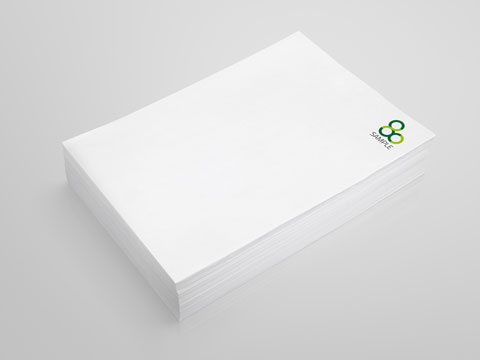It’s not always the more, the better: This holds true for the paper weight of A4 forms. Whether you should have your company letterhead or billing forms printed on 80, 90, 100 or even 120g/m2 depends on more than just looks and feel.
At first sight, the case seems clear: in light of minimal price differences (especially between 80 and 90 g/m2), the stronger letterhead seems to be the better choice in any case. Looks better right away, doesn’t it? Sure – but the extra weight can also have unwanted side effects. We have therefore taken a closer look at the advantages and disadvantages of the common grammages:
80g/m2: The standard – for good reasons
A grammage of 80g/m2 is standard for copy paper, and it is also popular for pre-printed letterheads. As uncoated paper, it is still stiff enough to pass through the office printer without problems and not show through, despite its light weight. However – such a paper does not look particularly noble or high-quality, but “only” clean and solid. But it does have one significant advantage: each A4 sheet weighs just under 5 g, so that a letter can contain up to three sheets and – including the DIN long envelope – still weigh less than 20 g. And these 20 g are precisely the weight limit for a so-called standard letter in Germany and Austria. At 90 g/m2 (5.6 g/sheet) it can be a bit tight – and the domestic letter postage in Germany can climb from 0.70 to 0.85 cents (in Austria even from 0.68 cents to 1 euro).
So anyone who often sends out invoices or letters with several pages is well served with 80 g paper. Those who use large quantities will also appreciate the savings in storage space and when filling the office printers.
90g/m2: The affordable middle class
If postage limits are not a big issue – for example in Switzerland, where every letter weighing up to 100 g costs the same – 90 g/m2 letterhead is the better choice. It looks a little more valuable and costs, if at all, only slightly more than the 80 g variant. The higher opacity is particularly noticeable when the paper is printed with an inkjet printer. But to the recipient of the 90 g letter, it is not yet a real eye-catcher.
100g/m2: Noticeably better
At 100g the effect is stronger: the layman can feel the higher weight, letters look more noble and personal. However, the additional costs for larger quantities are already noticeable, since this grammage is used less frequently and the production quantities are lower. This makes the 100 g paper a good choice for medium-sized and smaller companies as well as for freelancers and law firms who want to stand out from the crowd.
120g/m2: The beginning of the premium class
At the upper end of the scale for letterheads on offset paper is the basis weight of 120 g/m2. Despite its high stiffness, it still runs smoothly through printers and through folding and inserting machines. 120 g paper is perhaps a bit exaggerated for simple invoices and mass mailings. However, it is ideally suited for lawyers or management consultants, for example, who use it to present their expert opinions or fee notes – and for anyone who wants their correspondence to appear particularly high-quality. This thick paper is also suitable for full-surface printed backs, as the risk of showing through is higher with thin grades. The price of the 120 g paper is about twice as high as that of the 80 g variant – so it is still affordable.
Fine paper: True Luxury
Beyond the 120 g offset paper, there is still plenty of room to move upwards. This is not so much a matter of weight, but of special structures, surfaces or colours: So if you prefer an even more exclusive look and don’t have to stick to tight budget limits, you can choose so-called fine papers instead of ordinary offset papers. The variety in this segment is enormous, but so is the surcharge. Papers with a linen or felt structure, for example, or aquarelle paper-like grades are popular. If you would like to know more about this, it is best to seek personal advice – e.g. from prinux on 0800 100 2280 (toll-free from Germany and Austria) or 0800 100 228 (toll-free from Switzerland).
By the way, two rules apply to all papers:
- A high grammage alone does not guarantee high quality. A good, bright white 80 g paper can appear stiffer and cleaner than a wavy, dull white sheet of a higher weight class.
How a paper looks is best judged by a printed letter (using your own printer).
Do you want to have stationery printed for your company? Request free samples now
See for yourself – with the free prinux sample set for companies, organizations and freelancers. You will receive 1 sample letterhead each in DIN A4 format, printed on uncoated offset paper with 80, 90, 100 and 120 g/m2, which you can also send to your own printer for testing purposes.
Simply send an e-mail with the subject ” Stationery sample” and your company address to info@prinux.com. (Please understand that we can only offer this service to companies, organisations and freelancers).

